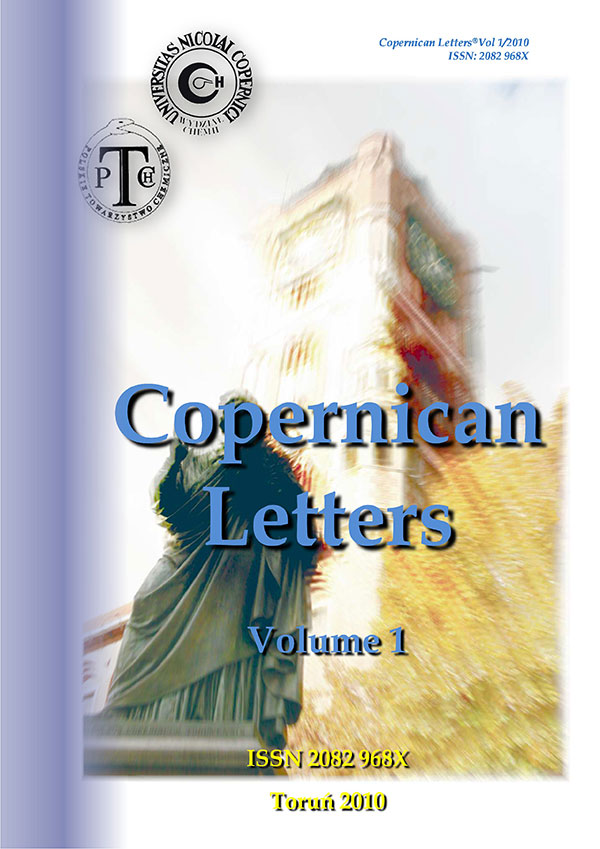The use of synthetic polypeptides in cosmetics
DOI:
https://doi.org/10.12775/CL.2010.010Abstract
Cosmetic peptides are one of the active components of modern day cosmetic preparation. Peptides are short chains sequences of amino acids. Amino acids are the basic building blocks of proteins and many other different types of organic molecules. Many skincare products use peptides to treat wrinkles. There are three main groups of anti wrinkle peptides: signal peptides, neurotransmitter–affecting peptides and carrier peptides. This article reviews the most popular peptides used in cosmetics. According to them established own sequences of peptides which were synthesized and used in the subsequent studies.
References
G. E. Farrar, A. Krosnick, Milestones in clinical pharmacology: wound healing.” Clin Ther, 1991: 13: 430– 434.
W. Goodson, D. Hohn, T. K. Hunt, “Augmentation of some aspects of wund healing by a “skin respiratory factor”.” J Surg Res, 1976: 21: 125–129.
J. P. Bentley, T. K. Hunt, J. B. Weiss, “Peptides from live yeast cell derivative stimulate wound healing.” Arch Surg, 1990: 125: 641–646.
S. O. Canapp, J. P. Farese, G. S. Schultz, “The effect of topical tripeptide–copper on healing of ischemic open wounds.” Vet Surg, 2003: 32: 515–523.
S. J. Keller, R. H. Levin, J. Frang, “Isolation and characterization of a tissue respiratory factor from bakers’ yeast.” J Cell Biol, 1991: 304: 21.
B. Kowalczyk, „Skora człowieka – anatomia i fizjologia skory.” Inventia Polish Technologies, 2006.
J. Dylewska–Grzelakowska, „Kosmetyka stosowana.” Wydawnictwo Szkolne i Pedagogiczne Społka Akcyjna, 1999.
A. Marzec, „Co powinniśmy wiedzieć o skorze.” Inventia Polish Technologies, 2001.
Magazyn kosmetyki profesjonalnej LES NOUVELLES ESTHETIQUES, numery: 1/2007, 3/2007, Beauty In Sp. z o. o., 2007.
Z. Adamski, A. Kaszuba, „Dermatologia dla kosmetologow.” AM Poznań, 2008.
M. P. Lupo, A. L. Cole, “Cosmeceutical peptides.” Dermatologic Therapy, 2007: 20: 343–349.
Ł. Pyzioł, „Przyszłość peptydow.” Serwis Biotechnologiczny/ dział Kosmetologia 2007.
K. Lintner, “Promoting production in the extracellular matrix without compromising barrier.” Cutis, 2002: 70 (6 suppl.): 13–16.
K. Katayma, J. Armendariz–Borunda, R. Raghow, “A pentapeptide from type I procollagen promotes extracellular matrix production.” J Biol Chem, 1993: 268: 9941–9944.
Centerchem:Syn®–Coll, http://www.ingredientstodiefor.com/files/DATA_Sy n–Coll.pdf;Basel, Switzerland, accessed 2006.
C. Blanes–Mira, J. Clemente, G. Jodas, “A synthetic hexapeptide (argireline) with anti–wrinkle activity.” Itn J Cosmet Sci, 2002: 24: 303–310.
L. M. Gutierrez, J. M. Cannes, A. V. Ferrer- Monteil, “A peptide that mimics the carboxy–terminal domain of SNAP–25 blocs Ca2+ – dependent exocytosis in chromaffin cells.” FEBS Lett, 1995: 372: 39–43.
L. M. Gutierrez, S. Viniegra, J. Reuda, “A peptide that mimics the C–terminal sequence of SNAP–25 inhibits secretory vesicle docking in chromaffin cells.” J Biol Chem 1997: 272: 2634–2639.
L. Pickart, M. M. Thaler, FEBS Letters, 1979: 104: 119-123.
Ch. Conato, R. Gavioli, R. Guerrini, H. Kozlowski, P. Mlynarz, C. Pasti, F. Pulidori, M. Remelli, Biochim. Biophys. Acta, 2001: 1526: 199-210.
L. Mazurowska, M. Mojski, Talanta, 2007: 72: 650-654.
L. Mazurowska, M. Mojski, J. Cosmet. Sci., 2008: 59: 59-69.
A. Simeon, H. Emonard, W. Hornebeck, ‘’The tripeptide–copper complex glycyl–L–histydyl–L–lysine– Cu2+ stimulates matrix metalloproteinase–2 expression by fibroblast cultures. ‘’ Life Sci, 2000: 67: 2257– 2265.
A. Simeon, Y. Wegrowsky, J. Bontemps, “Expression of glycosaminoglycan and small proteoglycans in wounds: modulation by the tripeptide–copper complex glycyl–L–histydyl–L–lysine–Cu2+.” J Invest Dermatol, 2000: 115: 962–968.
Downloads
Published
How to Cite
Issue
Section
Stats
Number of views and downloads: 1489
Number of citations: 0



